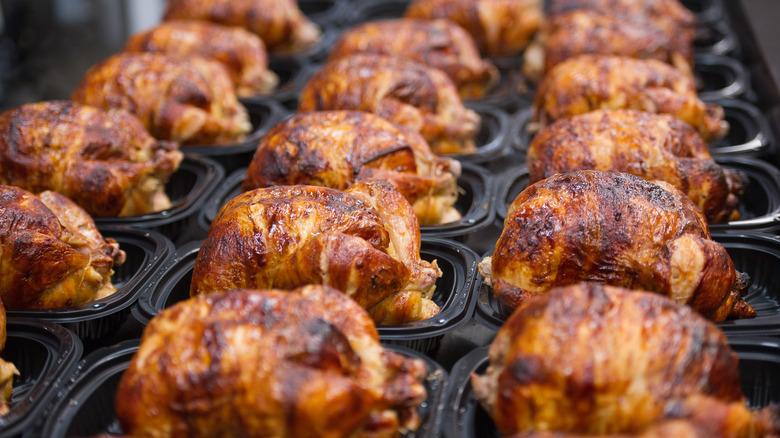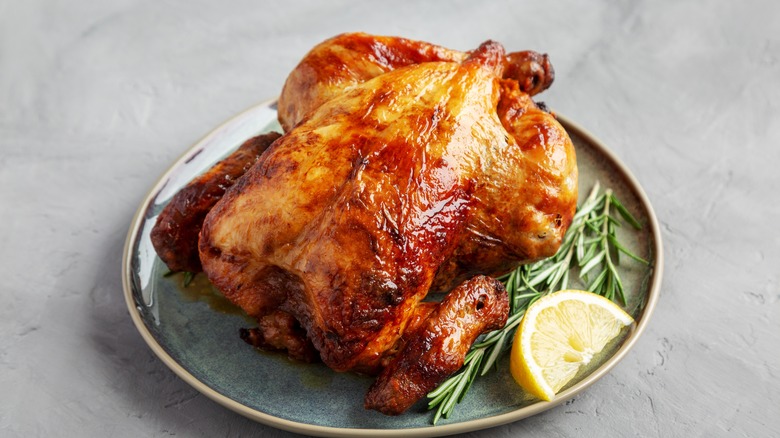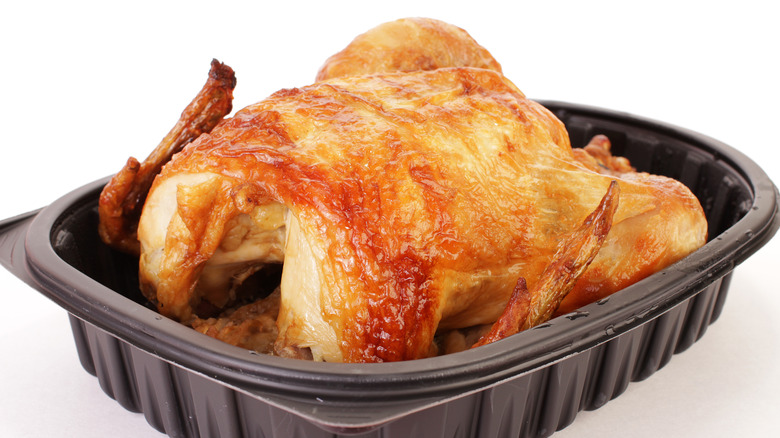How Much Meat Can You Get Off A Costco Rotisserie Chicken?
Priced at $4.99, Costco's rotisserie chickens are a deal for many shoppers, especially time-strapped families looking for a quick and convenient meal. But exactly how much chicken are you getting? When you take bones and other gristle out of the equation, Costco's chickens still yield a lot of meat.
Because rotisserie chickens vary in size, there are likely to be some discrepancies in how much meat an individual chicken will yield. But you should expect anywhere from a pound to two pounds of meat. At least, that's what fellow Costco shoppers have shared. Taking to Reddit, some shoppers have revealed how much meat their Costco chickens apparently had. One person commented, "On one I measured, I got 1 lb 13 oz. Idk how well I picked it or how much I ate while doing it though." Another wrote, "I buy several often to shred and weigh for a recipe. They hit, on average, just over 2 pounds each."
If you remove both the bones as well as the skin from your bird, you can expect about 60% of the chicken to be meat. A 2.2-pound chicken would have about 1.7 pounds of meat, for instance. With that said, rotisserie chickens are convenient, but they don't necessarily have the most meat.
Rotisserie chickens are smaller
If you're planning to feed a large family, you may want to consider buying two rotisserie chickens instead of one. Rotisserie chickens are often smaller than raw chickens that you buy in the store. A large broiler chicken can give you around five pounds of meat after it's been cooked. While Costco runs its poultry production to keep costs down, many chains sell smaller birds as well. This is also factoring in the fact that chickens generally lose 25% of their mass after being cooked.
Using smaller birds for rotisserie chicken allows grocery chains to sell their supply. John Stanton, a food marketing professor at St. Joseph's University, explained to Hi's Eye in 2019, "When smaller chickens come in, stores will often have trouble selling them. But when they are turned into rotisserie chickens, there's no problem. It's an easy way to get rid of smaller birds." However, it can benefit customers as well.
Larger birds typically don't cook as quickly as smaller birds and can stall the rotisserie process, which is why many chains cook a certain weight of chickens. Despite using smaller birds, some chains are still operating at a loss when it comes to rotisserie chickens. But is the meal worth it to consumers?
Weighing at the scale
From a quantity of meat perspective, it may be better to buy a raw chicken and cook it yourself. You'll get more meat if you buy a larger bird than the ones sold in the grocery deli. Additionally, you may save money — about $6 total, according to the Penny Hoarder. However, it's hard to ignore the convenience of rotisserie chickens when it comes to saving time. (Just consider the fact that Costco sells, on average, over more than 100 million rotisserie chickens per year.)
When it comes to feeding your family, you'll have to weigh the cost of convenience versus the amount of meat. A single rotisserie chicken should feed three or four people, on average. Outside of a traditional chicken dinner, there are ways of stretching that meat even further.
Try some of these clever ways of taking your rotisserie chicken to the next level. For one, you can use a bit of that extra meat in a homemade soup or chili. Another convenient way to maximize the number of meals you can get is to use rotisserie chicken as the headliner for a street taco. Combine the meat with sour cream and whatever fixings you prefer.


